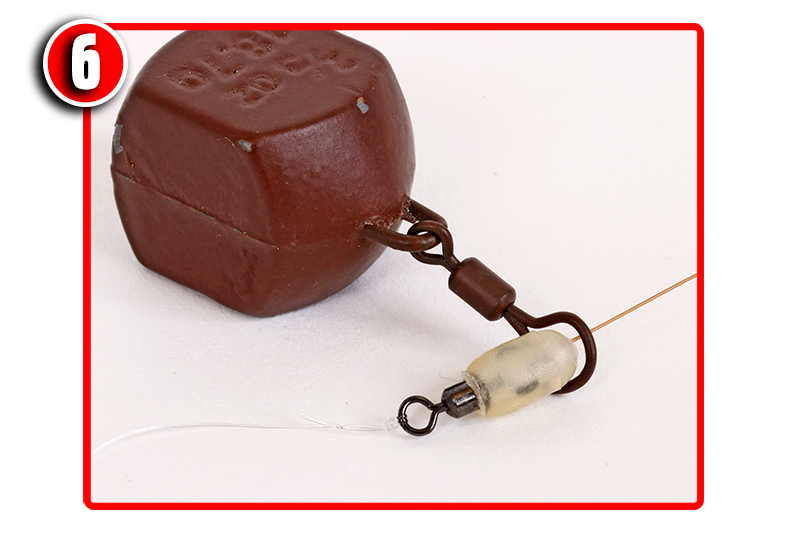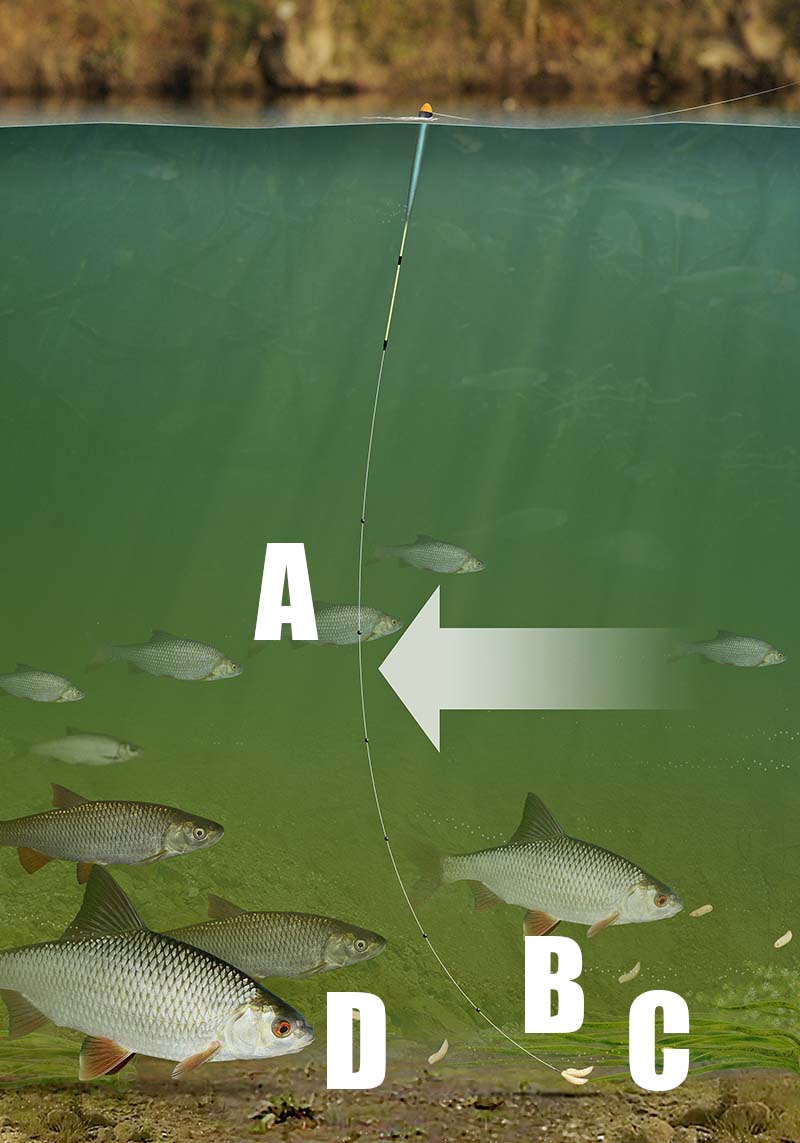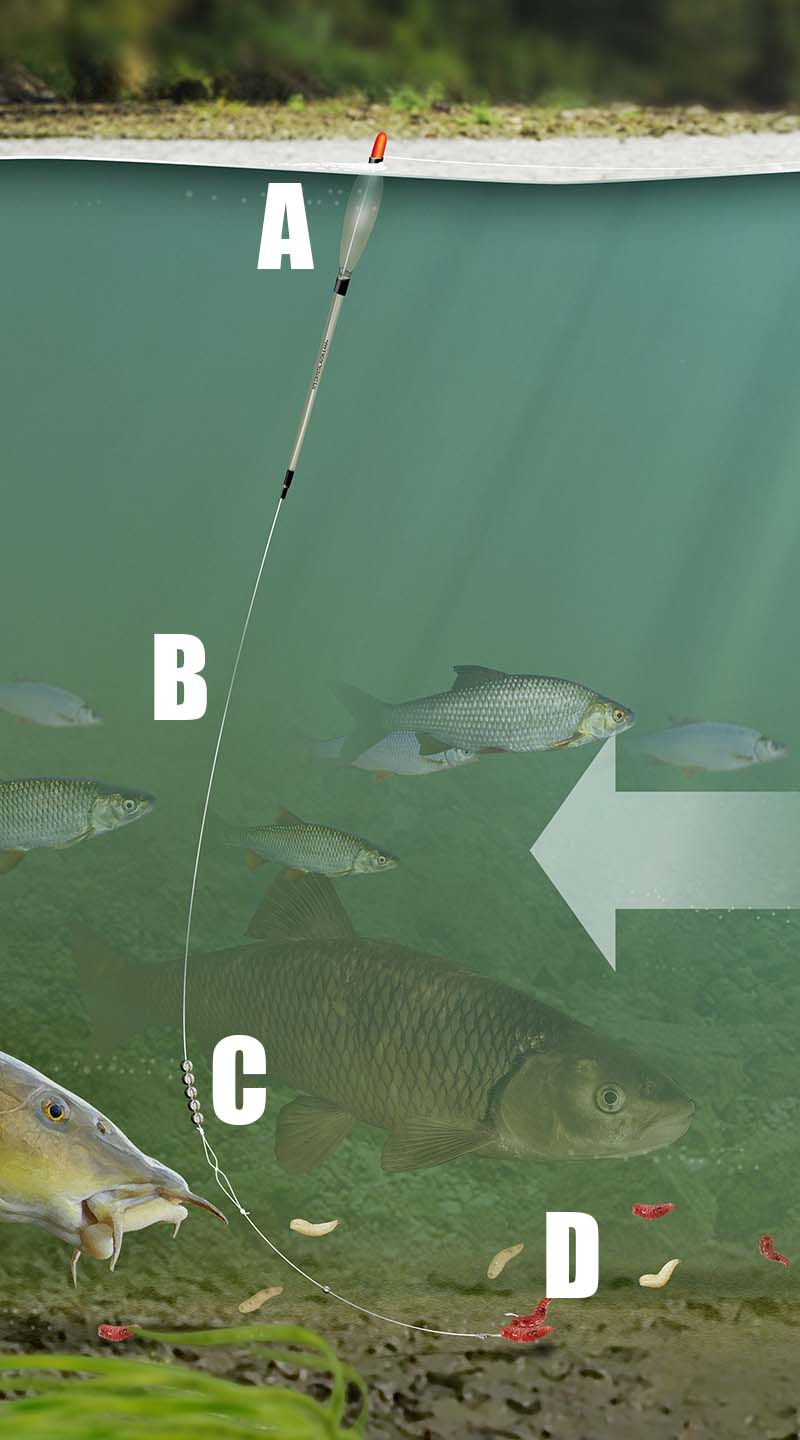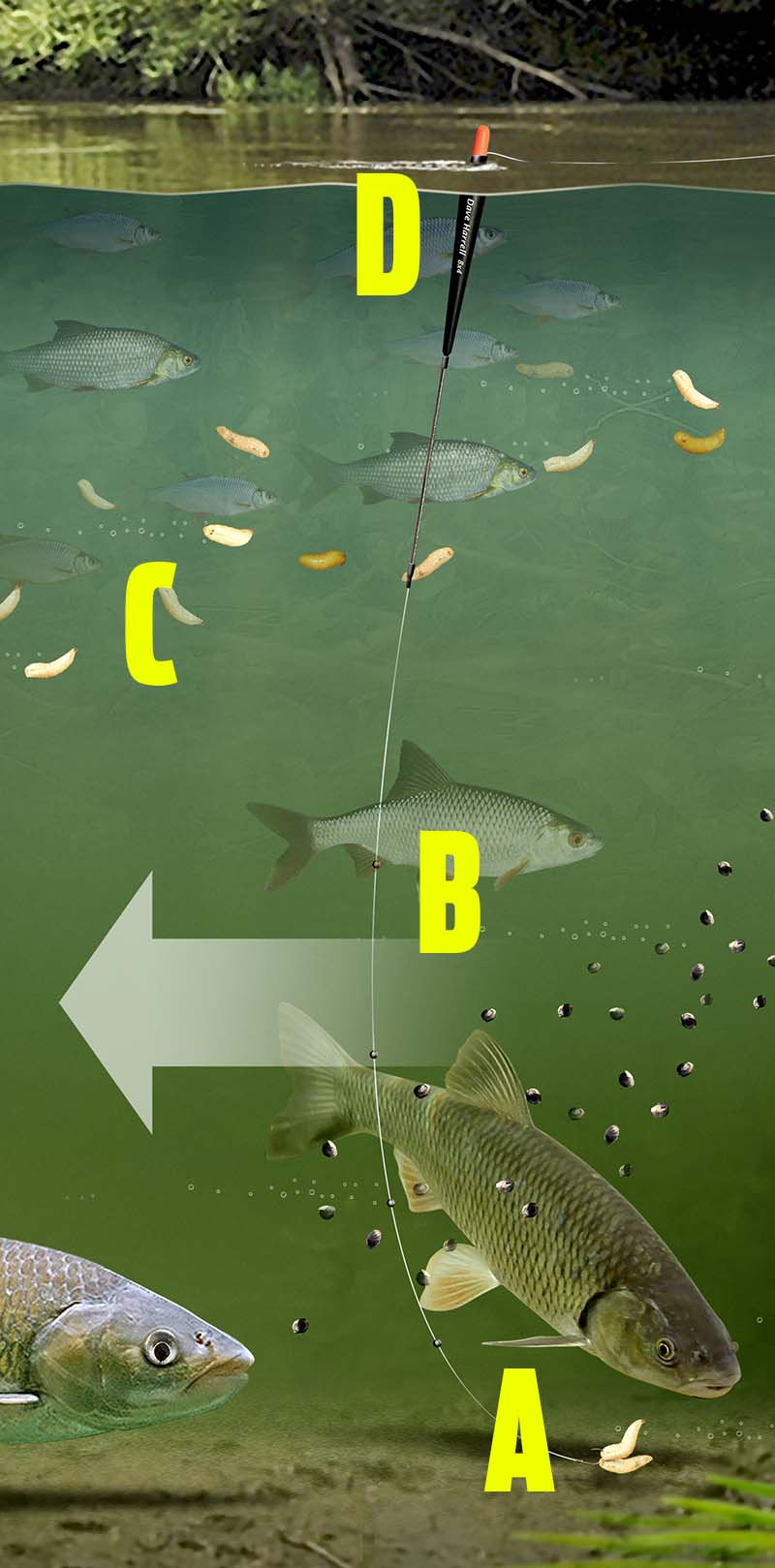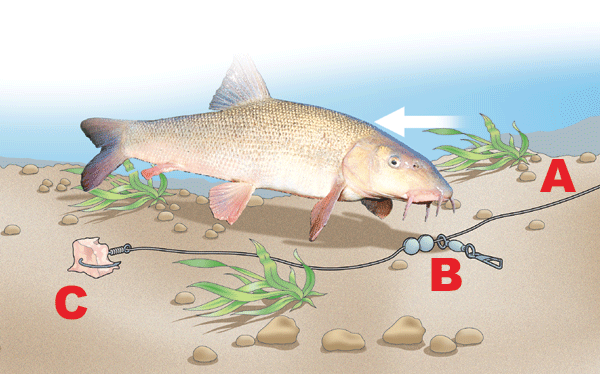How to tie | Carp and tench float leger rig
An important rig for any budding carp, tench or bream angler is the float ledger rig as it helps target species which prefer an absolutely static bait. Use strong line and hooks with this rig, and big baits such as worms, bread, or mini boilies.
A large bodied waggler is required as the buoyant stem is less likely to be pulled under by the tow. Bites are normally indicated by the float shooting under.
A good tactic is to find the bottom of the marginal shelf – where the bottom levels out – and then set the float slightly overdepth. Now, when you tighten up the line, the float will slowly sink down to the correct position and the line will be tight from rod to the leger weight.
If you find yourself fishing a lake this year with the wind blowing straight towards you, or from side-to-side, and holding position is proving impossible, then try out this very effective, but surprisingly underused rig to give you the correct bait presentation to encourage bites. Check out our step by step guide below and tie it yourself.
Trap the float on the mainline with two float stops. The float should be a large bodied waggler as this is more stable in undertow
Use a swivel leger weight of between ¹/2 to 2/3 ounce. This should be free-running on the mainline for sensitive bite indication
Thread a mini buffer bead on to the mainline and then attach a mini swivel to the mainline using a four-turn grinner knot
Tie a size 12 hook to 10 inches of 5lb hooklength line. Use either a grinner or through-the-eye whipping knot
You need to keep the hooklength short – about 4in-6in will be perfect. Tie the end of this to the mini swivel
The lead weight will sit just above the buffer bead, creating a bolt-effect. Adjust the float so that just the tip is showing
Rolling bait rig for river chub and barbel
This rig is brilliant for tackling chub and barbel from small rivers and streams. It requires very little tackle and can be fished with either an Avon rod, a quivertip rod or even a substantial waggler rod.
It can be fished in two styles - either by holding the rod at all times to feel for bites, or by placing the rod in rests and occasionally paying out line from the reel to allow the rig to trundle downstream.
It's a deadly technique for running baits downstream and underneath overhanging snags, weed rafts or within undercut banks where big chub and barbel live.
A You can use either braid of mono for this rig. But whichever you decide, always fish it direct to the hook. As you may be fishing tight to snags opt for a strong mono of no less than 6lb.
B The right amount of weight is an issue with this rig as you must use enough weight to keep the bait on the bottom in the flow. Using a snap link swivel stopped by a couple of BB shot is ideal as you can clip-on any additional Arlesey bombs to cope with stronger flows when roving different swims.
C Although this rig is commonly associated with meat, it can be used with almost any bait providing it sinks. Experiment with hair rigs if you are missing bites, and remember to use substantial hooks to battle with the big fish in strong flows.
How to fish for carp with popped-up bread crust and bread flake
All anglers know that carp are suckers for bread crust fished on the surface in the summer, but it is often a very underused bait at all other times of the year. Here we show you how it can be used to catch more carp just off the bottom of stillwaters at any time of the year.
Bread crust and bread flake, by their very nature, are buoyant baits. So they are perfect for use just off the bottom, above any silt or blanket weed.
This is a really simple rig to create, it’s virtually tangle-free, and it’s really productive too with many carp being caught in pleasure and match sessions over the past season.
Here’s how to create it…
A Your mainline needs to be quite substantial as there is a high chance that you could encounter some very big carp. We would suggest using 6lb as a minimum.
B In order to ensure that the rig is as resistance-free as possible, it’s best to use a short length of line between your leger bomb and your swivel. A 4ins length of strong mainline will be ideal. At one end tie a large swivel, and at the other tie a snap link swivel as this will allow you to chance your lead in seconds if you need a different weight of lead to cast further.
C A leger stop is the ideal item to use to prevent the swivel from slipping down to the hook. If you do not have any leger stops, use a small split shot.
D Your hooklength shouldn’t be too long. Around 6ins is about right. Again you will need to choose a lien that’s strong enough for the carp, so 6lb is a good starting point.
E A large hook is paramount here. Something like a size 10, 8 or even 6 could be used as the swollen bread will help mask the hook once it’s submerged.
A note worth mentioning here is that you will need to cast very gently to prevent the bread coming off the hook. Use a gentle sweeping motion to launch the rig, rather than a punch.
Resistance-free running rig for big perch
This is THE rig to use if you are targeting specimen perch. Although it’s quite simple to tie, the components you will need are quite specialised but can be bought from all good tackle shops.
A Run Ring is a must because this provides a large diameter bore through which the line passes, therefore resistance is kept to a minimum. Big perch will drop a legered bait if they feel the slightest resistance.
The Run Ring will need covering with some silicone tubing to prevent tangles, and then a snap link swivel can be clipped to the Run Ring so that any weight of lead can be used quickly and easily.
The best hooklength lines should be soft, supple and camouflaged – either a braid or clear mono is ideal. Length needs to be between 2ft and 4ft.
One of the best baits for big perch is a couple of lobworms, so this means that the hook will need to be quite large. A size 4 wide gape will be ideal, preferably barbed so that the worms remain on the hook.
A Use a Run Ring followed by a bead and a swivel. The Run Ring reduces the amount of resistance to the taking fish.
B The size and weight of lead ought to suit the distance that you intend casting. You could switch the lead for a feeder crammed with red maggots or chopped worms if you wish.
C It’s best to incorporate a snap link swivel into this rig so you can change the lead quickly at any stage during the session.
D Use a large swivel and a very strong knot to lock on your hooklength as there’s every chance you may encounter a large tench, carp or bream fishing with this rig.
E Hooklengths need to be strong and short – 2ft to 4ft is ideal and between 4lb and 8lb is best.
F When fishing with two lobworms hook them in the saddle with a wide gape size 4 hook.
G Chop and change your baits between using whole lobworms and broken lobworms to find out which bait the fish respond to best.
Snag-free link legering rig for big barbel and chub
Barbel love to hide under or tight to streamer weed, sunken branches, tree roots and other submerged obstacles. That makes catching them really difficult.
Static leger rigs may seem to be the answer, but often they aren’t. A mistimed or an inaccurate cast might see the heavy rig land bang in the middle of the obstruction – not only snagging up, but also disturbing the fish in the swim.
If you’re overly tentative with your cast, your rig might land too far away and the barbel won’t want to move out from the sanctuary of the feature to take the bait, especially in daylight hours.
These are the times when a neat link leger rig really comes into its own.
A correctly balanced link leger not only allows the angler to reach the desired distance upon the cast, but it also allows you to let the bait trip gently downstream.
No longer will you have to accurately cast your rig onto an area the size of a dinner plate. With a link leger you can cast upstream of the fish-holding spot and gradually work it downstream right next to or even underneath the feature.
The key to a successful link leger rig is to use the right amount of weight upon the link. Basically you’ll need to squeeze enough split shot onto the link to ensure that the rig sinks quickly and just holds the bottom when the rod is placed upon the rests.
If you leave the rod alone, the rig will remain in place until a fish takes the bait or a large twig or strand of weed hits the mainline as it is swept downstream.
But if you gently lift the rod tip to dislodge the rig it will rise up off he bottom and be swept downstream a little closer to the snag. Now place the rods in the rest ready to detect your next bite.
You can slowly and steadily repeat this until the rig lies exactly where you want it to be.
But this link leger rig offers something a little unique. The split shot can quite easily fall off the link if they become snagged, therefore this rig is very fish-friendly and safe. It’s the perfect rig to use when you’re fishing very tight to snags.
HOW TO TIE A LINK LEGER RIG
You don’t need a huge array of tackle to create this rig. You will need some large split shot, your hook, your chosen hooklength material (braid or mono), strong mainline (around 6-8lb is ideal), a strong swivel and a swivel bead.
A – Your hook needs to match the species and the size of bait you are using. When fishing for barbel, use a very strong hook
B – Your hooklength needs to be strong enough to cope with the fight of a barbel. If you decide to use mono, opt for lines in the region of 6-10lb breaking strain. If you decide to use braid to camouflage it against the venue bottom, use 12lb breaking strain.
C – The best method of connecting your mainline to hooklength is to use a swivel.
D – A swivel bead is the perfect accessory for attaching the leger link. Thread your mainline through the bead end and thread 6ins of strong line through the swivel. Fold this line over and lock the two lengths of line together using enough split shot to hold the rig onto the bottom. The beauty of this style of creating a link leger is that the split shot can quite easily fall off the link if it becomes snagged, leaving you free to play the fish back to the net.
E – Your mainline needs to be reliable and strong. 6-10lb breaking strain is ideal for most barbel fishing situations.






